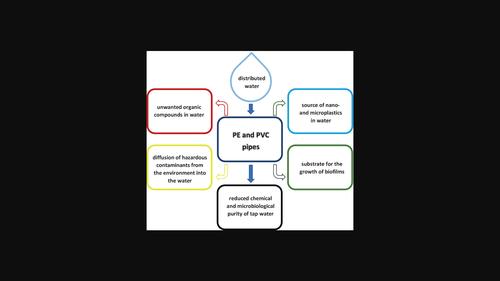Chemical and microbiological safety of drinking water in distribution networks made of plastic pipes
引用次数: 0
Abstract
In recent years, metal alloys used for drinking water distribution are gradually being replaced by PVC and HDPE pipes. In areas of distribution networks made of plastic, consumer complaints related to a significant deterioration of organoleptic parameters of water are frequently recorded. The decline in water quality is most likely the result of chemical and biological processes occurring on the inner walls of the transmission pipes coexisting with the disappearance of disinfectant residues. Plastic pipes are also characterized by high failure rates associated with aging of polymeric materials under operating conditions. Published reports indicate disturbing phenomena occurring in plastic pipes: oxidative aging of polymers, degradation of antioxidant coatings, release of organic compounds to water as well as surface damage and scaling, generating microplastic particles. PE and PVC networks are also susceptible to biofilm formation, characterized by a high phylogenetic diversity of microorganisms. Studies presented in the literature, indicating the risks resulting from the exploitation of PE and PVC pipes, are mainly based on model tests. There is a lack of works, which would complementarily explain all the phenomena occurring in working water pipes made of plastics. The aim of this review is to present the current state of knowledge regarding the phenomena and processes that can occur in PE and PVC pipes in service and their relevance to the safety and quality of drinking water in distribution networks, as well as to identify areas that require further analysis to enable water producers to deliver an appropriately high-quality product to consumers.

塑料管配网中饮用水的化学和微生物安全
近年来,用于饮用水配水的金属合金逐渐被PVC和HDPE管材所取代。在由塑料制成的配电网地区,经常记录到消费者对水的感官参数严重恶化的投诉。水质的下降很可能是在输水管道内壁发生的化学和生物过程与消毒剂残留消失共存的结果。塑料管的另一个特点是,在操作条件下,由于聚合物材料的老化,故障率也很高。已发表的报告指出,塑料管中出现了令人不安的现象:聚合物氧化老化、抗氧化涂层降解、有机化合物释放到水中,以及表面损坏和结垢,产生微塑料颗粒。PE和PVC网络也容易受到生物膜形成的影响,其特征是微生物的高度系统发育多样性。文献中提出的研究表明,PE和PVC管道的开采造成的风险,主要是基于模型试验。缺少工程,这可以补充解释塑料水管工作中出现的所有现象。本综述的目的是介绍目前关于在使用中的PE和PVC管道中可能发生的现象和过程的知识状况及其与分配网络中饮用水安全和质量的相关性,并确定需要进一步分析的领域,以使水生产商能够向消费者提供适当的高质量产品。
本文章由计算机程序翻译,如有差异,请以英文原文为准。
求助全文
约1分钟内获得全文
求助全文

 求助内容:
求助内容: 应助结果提醒方式:
应助结果提醒方式:


